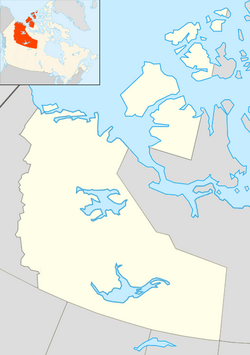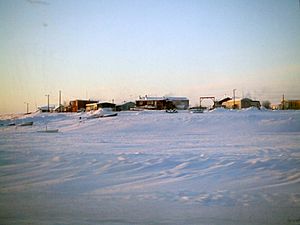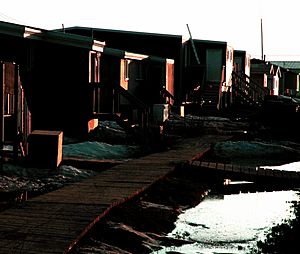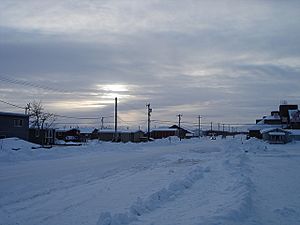Aklavik facts for kids
Quick facts for kids
Aklavik
Akłarvik
|
||
|---|---|---|
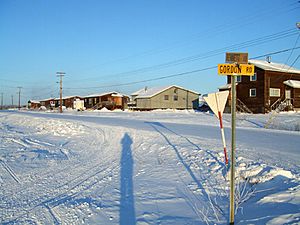
Aklavik in early-February 2008
|
||
|
||
| Motto(s):
Never Say Die
|
||
| Country | Canada | |
| Territory | Northwest Territories | |
| Region | Inuvik Region | |
| Constituency | Mackenzie Delta | |
| Census division | Region 1 | |
| Incorporated (hamlet) | 1 January 1974 | |
| Area | ||
| • Land | 14.47 km2 (5.59 sq mi) | |
| Elevation | 6 m (20 ft) | |
| Population
(2016)
|
||
| • Total | 590 | |
| • Density | 40.8/km2 (106/sq mi) | |
| Time zone | UTC– 07:00 (MST) | |
| • Summer (DST) | UTC−6 (MDT) | |
| Canadian Postal code |
X0E 0A0
|
|
| Area code(s) | 867 | |
| Telephone exchange | 375 878 978 | |
| – Living cost | 162.5 | |
| – Food price index | 170.5 | |
| Website | www.aklavik.ca | |
| Sources: Department of Municipal and Community Affairs Prince of Wales Northern Heritage Centre Canada Flight Supplement 2013 figure based on Edmonton = 100 2015 figure based on Yellowknife = 100 Elevation at airport |
||
Aklavik (pronounced ah-KLA-vik) is a small community called a hamlet in the Northwest Territories, Canada. Its name, Akłarvik, comes from the Inuvialuktun language and means "barrenground grizzly place."
For many years, until 1961, Aklavik was an important center for the government in the region. It had over 1,500 people living there. However, because the area often flooded, the government decided to build a new town, Inuvik, about 63 kilometers (39 miles) to the east. The plan was for everyone to move to Inuvik, but many people loved Aklavik and chose to stay. Thanks to their determination, Aklavik continued to thrive. In 2018, its population was 623. The current mayor of the hamlet is Andrew Charlie.
Contents
Aklavik's Story: A Look Back in Time
Aklavik started to grow in the early 1900s. The Hudson's Bay Company opened a trading post here in 1912. A trading post was a place where people could trade goods, often furs, for supplies. Later, in 1926, the Roman Catholic Church set up a mission, which is a place to help people and spread religious teachings.
Aklavik was located on the Peel Channel, which made it a key spot for transportation in the Mackenzie River area. It was also a great place for trapping animals.
Connecting the North: Radio and Communication
In October 1925, Aklavik became part of the Northwest Territories and Yukon Radio System (NWT&Y). This system was very important for connecting communities in Canada's North. It was run by the Royal Canadian Corps of Signals (RC Sigs), a part of the Canadian military.
The NWT&Y station in Aklavik, known by the call sign VEF, provided radio services to the people. It also helped aircraft flying over the area. If a plane didn't have a radio, it would fly low over the station so people could see it and record when it passed by.
In December 1946, a local radio station called "CHAK" started broadcasting in Aklavik. The "AK" in its name came from the first and last letters of "Aklavik." This station was built and run by a volunteer, WO2 R.A. (Red) McLeod, and helped connect the Mackenzie River delta.
From 1949 to 1961, the Royal Canadian Navy also had a special signals station in Aklavik. After it closed, its work moved to a new station in Inuvik.
A Famous Event: The "Mad Trapper"
In 1931, a man known as Albert Johnson, or the "Mad Trapper of Rat River," came to the area. An event involving him led to the first time airplanes and radio communications were used to track a person in the Canadian North. Museums in Aklavik and Fort Smith share more about this interesting part of history.
Saving Aklavik: A Community's Spirit
By the 1950s, Aklavik had grown to over 1,600 people. But the Peel Channel kept flooding, and the river banks were washing away. Because of this, the Canadian government built a new community, Inuvik, and planned to close Aklavik.
However, in the 1960s, the principal of Aklavik's school, A. J. (Moose) Kerr, started a group to save the community. Their hard work paid off, and Aklavik survived! The local school is now named after him.
Aklavik Today: Life in the Hamlet
Aklavik has a school for about 150 students, from Kindergarten all the way to Grade 12. For adults who want to learn more, Aurora College offers classes at the Community Learning Centre.
The community has three stores where people can buy groceries and other items: the Aklavik General Store, Stantons, and the Northern Store. There's also a police station with three officers, a health center with four nurses, and a Canada Post office. Visitors can stay at the Aklavik Lodge or Bessie's Boarding House. There are even two taxi companies!
Like many northern communities, Aklavik has a community hall for events and a gymnasium connected to the school. What's special is that it also has a swimming pool!
You can reach Aklavik by air through the Aklavik/Freddie Carmichael Airport. In winter, there's an ice road directly from Inuvik across the frozen Mackenzie Delta. When the river isn't frozen (usually June to September), float planes can land at the Aklavik Water Aerodrome.
Land Claims: Sharing the Land
Aklavik is unique because it's part of two different land claims areas: the Inuvialuit Settlement Region and the Gwich'in Settlement Region. This means that both the Inuvialuit and the Gwich'in Indigenous peoples have special rights and agreements about the land here.
- The Inuvialuit people's land claim, called the Inuvialuit Final Agreement, was settled in 1984. The Aklavik Community Corporation represents them.
- The Gwich'in people of Aklavik are covered by the Gwich'in Comprehensive Land Claim Agreement, signed in 1992. They are represented by the Ehdiitat Gwich'in Council and the Aklavik First Nation.
Indigenous Peoples of Aklavik
Aklavik is home to both Inuit and First Nations people.
- The Inuvialuit of Aklavik are mainly Uummarmiut. They are descendants of the Nunamiut people who moved from Alaska in the early 1900s. They speak Uummarmiutun, which is very similar to the Inupiaq language.
- The Gwich'in are a First Nations people who live in parts of Alaska, Yukon, and the Northwest Territories. They speak the Gwichʼin language, which is part of the Athabaskan language family.
Both Inuvialuktun (the language of the Inuvialuit) and Gwichʼin are official languages in the Northwest Territories. In 2009, almost 20% of the Indigenous population in the NWT spoke at least one Native language.
Weather in Aklavik
Aklavik has a subarctic climate, which is common in Canada's Arctic. This means it has mild summers and very cold winters that last for most of the year. Temperatures are often below freezing. It can even freeze at any time of the year!
| Climate data for Aklavik/Freddie Carmichael Airport | |||||||||||||
|---|---|---|---|---|---|---|---|---|---|---|---|---|---|
| Month | Jan | Feb | Mar | Apr | May | Jun | Jul | Aug | Sep | Oct | Nov | Dec | Year |
| Record high humidex | 10.5 | 2.0 | 8.1 | 16.6 | 27.8 | 35.7 | 35.5 | 33.8 | 26.5 | 16.4 | 4.3 | 5.5 | 35.7 |
| Record high °C (°F) | 6.7 (44.1) |
9.4 (48.9) |
11.0 (51.8) |
14.2 (57.6) |
25.0 (77.0) |
31.8 (89.2) |
33.9 (93.0) |
33.1 (91.6) |
27.6 (81.7) |
17.0 (62.6) |
6.7 (44.1) |
10.0 (50.0) |
33.9 (93.0) |
| Mean daily maximum °C (°F) | −22.3 (−8.1) |
−21.7 (−7.1) |
−16.4 (2.5) |
−6.7 (19.9) |
4.6 (40.3) |
16.5 (61.7) |
18.4 (65.1) |
15.0 (59.0) |
7.6 (45.7) |
−4.9 (23.2) |
−17.0 (1.4) |
−20.9 (−5.6) |
−4.0 (24.8) |
| Daily mean °C (°F) | −26.3 (−15.3) |
−25.7 (−14.3) |
−21.7 (−7.1) |
−12.5 (9.5) |
−0.1 (31.8) |
11.4 (52.5) |
13.9 (57.0) |
10.9 (51.6) |
4.4 (39.9) |
−7.6 (18.3) |
−20.7 (−5.3) |
−24.7 (−12.5) |
−8.2 (17.2) |
| Mean daily minimum °C (°F) | −30.2 (−22.4) |
−29.8 (−21.6) |
−27.0 (−16.6) |
−18.2 (−0.8) |
−4.8 (23.4) |
6.2 (43.2) |
9.4 (48.9) |
6.8 (44.2) |
1.2 (34.2) |
−10.2 (13.6) |
−24.2 (−11.6) |
−28.4 (−19.1) |
−12.4 (9.7) |
| Record low °C (°F) | −51.0 (−59.8) |
−52.2 (−62.0) |
−48.9 (−56.0) |
−42.2 (−44.0) |
−25.6 (−14.1) |
−6.7 (19.9) |
−11.1 (12.0) |
−3.9 (25.0) |
−14.0 (6.8) |
−35.1 (−31.2) |
−45.6 (−50.1) |
−47.8 (−54.0) |
−52.2 (−62.0) |
| Record low wind chill | −59.8 | −61.5 | −52.8 | −46.0 | −31.5 | −11.4 | 0.0 | −6.0 | −16.4 | −41.1 | −49.7 | −56.4 | −61.5 |
| Average precipitation mm (inches) | 15.0 (0.59) |
11.9 (0.47) |
13.8 (0.54) |
8.0 (0.31) |
14.8 (0.58) |
19.4 (0.76) |
40.6 (1.60) |
41.7 (1.64) |
30.6 (1.20) |
32.6 (1.28) |
22.0 (0.87) |
15.6 (0.61) |
265.8 (10.46) |
| Average rainfall mm (inches) | 0.0 (0.0) |
0.0 (0.0) |
0.0 (0.0) |
0.1 (0.00) |
5.4 (0.21) |
18.5 (0.73) |
40.6 (1.60) |
41.3 (1.63) |
23.7 (0.93) |
0.3 (0.01) |
0.0 (0.0) |
0.0 (0.0) |
129.8 (5.11) |
| Average snowfall cm (inches) | 15.0 (5.9) |
11.9 (4.7) |
13.8 (5.4) |
8.0 (3.1) |
9.5 (3.7) |
0.9 (0.4) |
0.0 (0.0) |
0.4 (0.2) |
6.9 (2.7) |
32.3 (12.7) |
22.2 (8.7) |
15.6 (6.1) |
136.3 (53.7) |
| Average precipitation days (≥ 0.2 mm) | 7.8 | 7.8 | 7.1 | 5.3 | 5.8 | 7.1 | 10.8 | 11.3 | 12.5 | 11.6 | 9.9 | 8.9 | 105.8 |
| Average rainy days (≥ 0.2 mm) | 0.0 | 0.0 | 0.0 | 0.0 | 2.1 | 6.7 | 10.8 | 11.3 | 10.4 | 0.5 | 0.0 | 0.0 | 41.9 |
| Average snowy days (≥ 0.2 cm) | 7.8 | 7.8 | 7.1 | 5.2 | 3.8 | 0.3 | 0.0 | 0.1 | 2.2 | 11.5 | 9.9 | 8.9 | 64.6 |
| Mean monthly sunshine hours | 13 | 94 | 177 | 277 | 297 | 401 | 276 | 206 | 95 | 72 | 22 | 0 | 1,930 |
| Source 1: Environment Canada Canadian Climate Normals 1981–2010 | |||||||||||||
| Source 2: Danish Meteorological Institute (sun, 1931–1960) | |||||||||||||
Who Lives in Aklavik?
| How Aklavik's Population Has Changed | ||
|---|---|---|
| Year | Pop. | ±% |
| 1971 | 661 | — |
| 1976 | 781 | +18.2% |
| 1981 | 721 | −7.7% |
| 1986 | 763 | +5.8% |
| 1991 | 801 | +5.0% |
| 1996 | 727 | −9.2% |
| 2001 | 632 | −13.1% |
| 2006 | 594 | −6.0% |
| 2011 | 633 | +6.6% |
| 2016 | 590 | −6.8% |
| 2021 | 536 | −9.2% |
| Source: Statistics Canada |
||
|
||||||||||||||||||||||||||||||||||||||||||||||||||||||||||||||||||||||||||||||
In the 2021 Census, Aklavik had a population of 536 people. This was a small decrease from its 2016 population of 590.
Most of the people in Aklavik, about 93.2%, are Indigenous. This is similar to many other communities in the Northwest Territories. However, Aklavik is special because it has a large number of both First Nations people (33.9%) and Inuit people (53.4%). There are also a small number of Métis people (4.2%) and non-Indigenous people (8.5%).
In 2017, about 14% of Aklavik's residents were 9 years old or younger. About 6.9% were between 10 and 14 years old, and 14.2% were between 15 and 24. The median age in Aklavik in 2016 was 31.8 years. This means half the people were younger than 31.8 and half were older.
Famous People from Aklavik
Aklavik has been home to several notable individuals:
- Frank Carmichael – A trapper and former politician for the Mackenzie West and Mackenzie Delta areas.
- Nellie Cournoyea – A former Premier of the Northwest Territories, a very important leader.
- Glenna Hansen – A former Commissioner of the Northwest Territories, another key leader.
- Robert C. McLeod – A politician for the Inuvik Twin Lakes area.
- Abe Okpik – The first Inuk (Inuit person) to be part of the Legislative Assembly of the Northwest Territories. He also led "Project Surname" to help Inuit people get surnames instead of numbers.
- Rick Rivet – A Sahtu–Métis artist known for his Neo-Expressionist paintings.
- Vince Steen – A former politician for the Nunakput area.
- Willie Thrasher – A talented musician.
See also
 In Spanish: Aklavik para niños
In Spanish: Aklavik para niños



